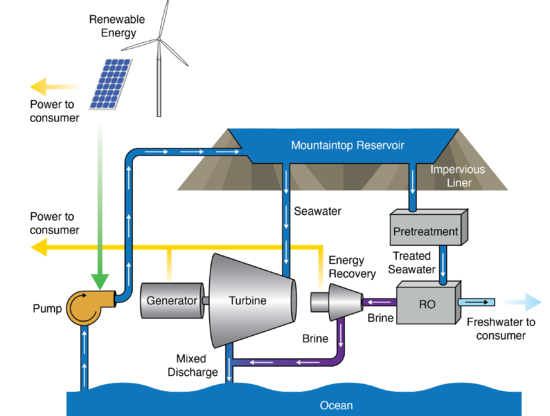Variable Emissivity Materials For Spacecraft
Roadmap Overview
- 1ICPHROS - Integrated and Co-located Pumped Hydro Reverse Osmosis System
 <ref>Oceanus Power & Water. https://www.oceanus.pw/. Accessed 27 Oct. 2020.</ref>
<ref>Oceanus Power & Water. https://www.oceanus.pw/. Accessed 27 Oct. 2020.</ref>
The United Nations identified safe drinking water and affordable, sustainable energy as two of its seventeen Sustainable Development Goals demonstrating the world-wide need for these commodities. Of note, 1 in 3 people in the world do not have access to safe drinking water and 13% of the world does not have access to modern electricity.<ref>United Nations Sustainable Development Goals. https://www.un.org/sustainabledevelopment/; Accessed Nov 2020.</ref> The integration and co-location of pumped hydro storage, hydropower and reverse osmosis desalinization plants provide both an affordable energy and freshwater source by optimizing efficiency and offsetting capital investments, reoccurring operations and maintenance costs and reducing risk to investors. Pumped hydro energy storage utilizes low cost, excess renewable energy (typically solar or wind) to pump seawater up to an elevated reservoir. When demand exceeds renewable power generation capacity, the elevated seawater is fed to hydro turbines at a lower elevation, at pressure, to generate electrical power for the grid. A small portion of the pressurized water is concurrently routed to the reverse osmosis desalinization plant under pressure, again at a lower elevation, negating the need for duplicative generators to produce freshwater. Shared infrastructure between the two systems, including the pumps, turbines, penstocks, piping and storage tanks, reduces not only capital expenditures but also operations and maintenance costs. In addition to affordable power and water, this integrated solution is environmentally friendly and neutralizes a negative by-product of the desalination process. The brine residual produced during the desalinization process is mixed with the outflow of the hydro turbines, effectively diluting the environmentally harmful solution before its return to the ocean.
Design Structure Matrix (DSM) Allocation
This technology integrates two existing technologies in pumped hydro energy storage and reverse osmosis desalination into a co-located, symbiotic system. The DSM and formal breakdown illustrate this relationship where both systems share common components and sub-systems in order to deliver the emergent value. The "X" marks indicate physical interactions within the DSM. The Integrated Hydrogen Production system is a futuristic goal that takes advantage of both energy and freshwater being co-located to efficiently generate a third revenue stream. However, this portion of the system is not mature.


